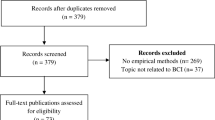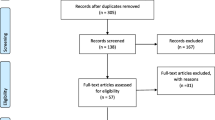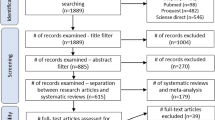Abstract
This article reports a systematic review of research done about the positive impact of cognitive treatment for people with some type of brain disorder through the use of inclusive technologies. The article collected 21 publications of high impact magazines uncovering that countries such as Spain, France, and Russia have a significant number of contributions on this topic. Inclusive technological innovations which are intended for work on brain functions such as attention, memory, verbal fluency, problem-solving and behavior regulation have been mainly developed in devices such as Tablets and Robots. The data discussed highlights the need to continue in this line of research to determine the effect of this type of intervention, as well as the future projection of developing new technological devices facilitating human brain functions.
Access this chapter
Tax calculation will be finalised at checkout
Purchases are for personal use only
Similar content being viewed by others
References
Petersen, K., Feldt, R., Mujtaba, S., Mattsson, M.: Systematic mapping studies in software engineering. In: Ease, vol. 17, pp. 68–77 (2008)
Sánchez, A., Barreiro, J., Maojo, V.: Design of virtual reality systems for education: a cognitive approach. Educ. Inf. Technol. 5, 345–362 (2000). https://doi.org/10.1023/A:1012061809603
Agarwal, C., Chakraborty, P.: A review of tools and techniques for computer aided pronunciation training (CAPT) in English. Educ. Inf. Technol. 24(6), 3731–3743 (2019). https://doi.org/10.1007/s10639-019-09955-7
López, J., Pina, V., Ballesta, S., Bordoy, S., Pérez, L.: Proyecto Petit U Binding: método de adquisición y mejora de la lectura en primero de primaria Estudio de eficacia. Revista de Logopedia, Foniatría y Audiología 40(1), 12–22 (2020). https://doi.org/10.1016/j.rlfa.2019.06.001
Herrero, J.F., Lorenzo, G.: An immersive virtual reality educational intervention on people with autism spectrum disorders (ASD) for the development of communication skills and problem solving. Educ. Inf. Technol. 25(3), 1689–1722 (2019). https://doi.org/10.1007/s10639-019-10050-0
Parilová, T.: DysHelper – the dyslexia assistive approach user study. In: ICCHP: Computers Helping People with Special Needs, pp. 478–485 (2018). https://doi.org/10.1007/978-3-319-94277-3_74
Moher, D.: Preferred reporting items for systematic review and meta-analysis protocols (PRISMA-P) 2015 statement. Syst. Rev. 4(1), 1–9 (2015). https://doi.org/10.1186/2046-4053-4-1
Mehrle, D., Strosser, A., Harkin, A.: Walk-modularity and community structure in networks. Netw. Sci. 3(3), 348–360 (2015). https://doi.org/10.1017/nws.2015.20
Portuguez, M.: Innovación educativa en estudios sobre el desarrollo y uso de la tecnología: una revisión sistemática de literatura (2019). https://doi.org/10.13140/RG.2.2.16297.75360
Pellas, N., Kazanidis, I., Palaigeorgiou, G.: A systematic literature review of mixed reality environments in K-12 education. Educ. Inf. Technol. 25(4), 2481–2520 (2019). https://doi.org/10.1007/s10639-019-10076-4
Apendix: References of articles revised
Ferrández Vicente, J.M., Álvarez-Sánchez, J.R., de la Paz López, F., Toledo Moreo, J., Adeli, H. (eds.): Understanding the Brain Function and Emotions. Lecture Notes in Computer Science (2019). https://doi.org/10.1007/978-3-030-19591-5
Kotov, S.V., Isakova, E.V., Sheregeshev, V.I.: Possibilities for correcting emotional and behavioral impairments in stroke patients during rehabilitation therapy. Neurosci. Behav. Physiol. 50(2), 156–161 (2019). https://doi.org/10.1007/s11055-019-00882-1
Diaz-Orueta, U., Etxaniz, A., Gonzalez, M.F., Buiza, C., Urdaneta, E., Yanguas, J.: Role of cognitive and functional performance in the interactions between elderly people with cognitive decline and an avatar on TV. Univers. Access Inf. Soc. 13(1), 89–97 (2013). https://doi.org/10.1007/s10209-013-0288-1
Tröger, J., Linz, N., König, A., Robert, P., Alexandersson, J.: Telephone-based dementia screening I: automated semantic verbal fluency assessment. In: Proceedings of the 12th EAI International Conference on Pervasive Computing Technologies for Healthcare - PervasiveHealth 2018 (2018). https://doi.org/10.1145/3240925.3240943
Chan, J., Nejat, G.: The design of an intelligent socially assistive robot for person-centered cognitive interventions. In: 34th Annual Mechanisms and Robotics Conference, Parts A and B, vol. 2 (2010). https://doi.org/10.1115/detc2010-28681
Anguera, J.A., et al.: Video game training enhances cognitive control in older adults. Nature 501(7465), 97–101 (2013). https://doi.org/10.1038/nature12486
Bourrelier, J., Ryard, J., Dion, M., Merienne, F., Manckoundia, P., Mourey, F.: Use of a virtual environment to engage motor and postural abilities in elderly subjects with and without mild cognitive impairment (MAAMI project). IRBM 37(2), 75–80 (2016). https://doi.org/10.1016/j.irbm.2016.02.007
Garcia-Sanjuan, F., Jaen, J., Nacher, V.: Tangibot: a tangible-mediated robot to support cognitive games for ageing people—a usability study. Pervasive Mob. Comput. 34, 91–105 (2017). https://doi.org/10.1016/j.pmcj.2016.08.007
Diep, C., Ftouni, S., Manousakis, J.E., Nicholas, C.L., Drummond, S.P.A., Anderson, C.: Acoustic slow wave sleep enhancement via a novel, automated device improves executive function in middle-aged men. Sleep (2019). https://doi.org/10.1093/sleep/zsz197
Redrovan-Reyes, E., et al.: An educational platform based on expert systems, speech recognition, and ludic activities to support the lexical and semantic development in children from 2 to 3 years. Paper presented at the 2019 IEEE Colombian Conference on Communications and Computing, COLCOM 2019 - Proceedings (2019). https://doi.org/10.1109/ColComCon.2019.8809118
Cruz-Sandoval, D., Favela, J.: Incorporating conversational strategies in a social robot to interact with people with dementia. Dement. Geriatr. Cogn. Disord. 47(3), 140–148 (2019). https://doi.org/10.1159/000497801
Vásquez, C., et al.: Interactive system for language and communication stimulation directed to young children. Paper presented at the International IEEE/EMBS Conference on Neural Engineering, NER, 2019-March 9–12 (2019). https://doi.org/10.1109/NER.2019.8717073
Zermatten, V., Rochat, L., Manolov, R., Van der Linden, M.: Can an external device create and trigger intention in a patient with a severe brain injury? Neuropsychol. Rehabil. 28(7), 1211–1228 (2018). https://doi.org/10.1080/09602011.2016.1255230
Dauvergne, C., Bégel, V., Gény, C., Puyjarinet, F., Laffont, I., Dalla Bella, S.: Home-based training of rhythmic skills with a serious game in parkinson’s disease: usability and acceptability. Ann. Phys. Rehabil. Med. 61(6), 380–385 (2018). https://doi.org/10.1016/j.rehab.2018.08.002
Kokubo, N., et al.: A new device-aided cognitive function test, user experience-trail making test (UX-TMT), sensitively detects neuropsychological performance in patients with dementia and parkinson’s disease. BMC Psychiatry 18(1), 1–10 (2018). https://doi.org/10.1186/s12888-018-1795-7
Kasatkin, V.N., Anisimov, V.N., Dreneva, A.A., Borodina, I.D., Karelin, A.F., Rumyantsev, A.G.: The use of the visuo-motor reaction training device for the improvement of the coordination in the eye-hand system of the children and adolescents following the completion of the antineoplastic treatment of brain tumours. [Primenenie trenazhera zritel'no-motornoĭ korrektsii dlia uluchsheniia koordinatsii v sisteme glaz-ruka u deteĭ i podrostkov posle zaversheniia protivoopukholevoĭ terapii novoobrazovaniĭ golovnogo mozga] Voprosy Kurortologii, Fizioterapii, i Lechebnoi Fizicheskoi Kultury 95(6), 13–18 (2018). https://doi.org/10.17116/kurort20189506113
Abu Hashim-de Vries, A.H., Ismail, M., Mohamed, A., Subramaniam, P.: Weaving the non-pharmacological Alzheimer’s disease therapy into mobile personalized digital memory book application (2018). https://doi.org/10.1007/978-3-319-77712-2_49
Dethlefs, N., Milders, M., Cuayáhuitl, H., Al-Salkini, T., Douglas, L.: A natural language-based presentation of cognitive stimulation to people with dementia in assistive technology: a pilot study. Inform. Health Soc. Care 42(4), 349–360 (2017). https://doi.org/10.1080/17538157.2016.1255627
Goncalves, V., Gil, H.: Digital technologies - apps - and the cognitive skills of older adults: results of an investigation at USALBI (Universidade Senior Albicastrense). Paper presented at the Iberian Conference on Information Systems and Technologies, CISTI (2017). https://doi.org/10.23919/CISTI.2017.7976001
Ginis, P., Heremans, E., Ferrari, A., Bekkers, E.M.J., Canning, C.G., Nieuwboer, A.: External input for gait in people with Parkinson’s disease with and without freezing of gait: one size does not fit all. J. Neurol. 264(7), 1488–1496 (2017). https://doi.org/10.1007/s00415-017-8552-6
Acknowledgments
The authors of this work thank CEDIA for the financing within the CEPRA project Integration of New Technologies for the Design of Cognitive Solutions in Assisted Living Environments for Older Adults: Evaluation of Attention and Memory Areas.
Author information
Authors and Affiliations
Corresponding author
Editor information
Editors and Affiliations
Rights and permissions
Copyright information
© 2021 The Author(s), under exclusive license to Springer Nature Switzerland AG
About this paper
Cite this paper
Ramos-Galarza, C., Cóndor-Herrera, O., Arias-Flores, H., Jadán-Guerrero, J., Bolaños-Pasquel, M., Cedillo, P. (2021). Cognitive Interventions Based on Technology: A Systematic Literature Review. In: Ayaz, H., Asgher, U., Paletta, L. (eds) Advances in Neuroergonomics and Cognitive Engineering. AHFE 2021. Lecture Notes in Networks and Systems, vol 259. Springer, Cham. https://doi.org/10.1007/978-3-030-80285-1_30
Download citation
DOI: https://doi.org/10.1007/978-3-030-80285-1_30
Published:
Publisher Name: Springer, Cham
Print ISBN: 978-3-030-80284-4
Online ISBN: 978-3-030-80285-1
eBook Packages: EngineeringEngineering (R0)




